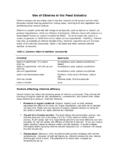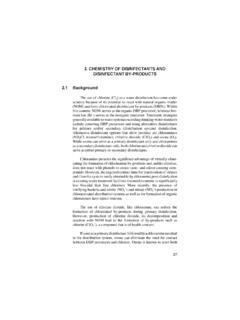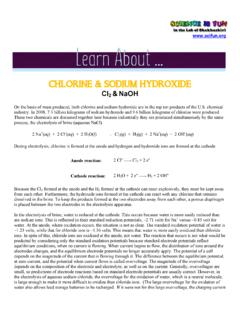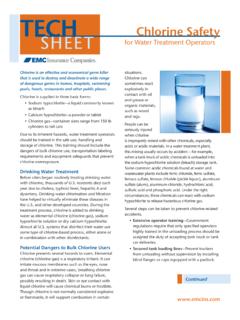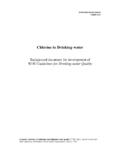Transcription of MATERIAL SAFETY DATA SHEET - Chlorine | CL2
1 1 MATERIAL SAFETY data SHEET ASHTA Chemicals Inc. Box 858 Ashtabula, OH 44004 (440) 997-5221 Chlorine LIQUID CHEMTREC:(800) 424-9300 SECTION I MATERIAL IDENTIFICATION CHEMICAL NAME: Chlorine NO.: 7782-50-5 TRADE NAME: Chlorine , Compressed Chlorine FIFRA: #21139-1 SYNONYMS: Liquid Chlorine SARA 312/313: Yes CHEMICAL FORMULA: Cl2 CERCLA: Yes CHEMICAL FAMILY: Halogen TSCA INVENTORY: Yes REGISTRY: 3-0-0-OXY HMIS: 3-0-0-G LABELING: Poison gas, corrosive REPORTABLE QUANTITY: 10 Lbs.
2 WHMIS: 1% OSHA PSM: 1500 lbs IDENTIFICATION NO.: UN 1017 LISTED:Marine Pollutant SHIPPING NAME: Chlorine HAZARD GUIDE: #124 HAZARD CLASS: PLACARD: UN 1017 SECTION II INGREDIENTS AND HAZARDS PRINCIPAL COMPONENT: Chlorine PERCENT: Essentially 100% HAZARDOUS MIXTURES OF OTHER LIQUIDS, SOLIDS OR GASES: Chlorine is one of the chemical elements. This substance can be absorbed into the body by inhalation and is corrosive to the eyes, skin and respiratory tract.
3 Serious cases may be fatal. ADDITIONAL INFORMATION: ACGIH TLV = PPM (TWA), 1 PPM STEL OSHA PEL = 1 PPM SECTION III PHYSICAL data BOILING POINT: F or C pH: Non-aqueous SPECIFIC GRAVITY (H2O=1): Liquid At 0 C = VAPOR PRESSURE (PSIG): At 70 F = VAPOR DENSITY (Air = 1): APPEARANCE/ODOR: Gas is greenish yellow, liquid is amber. Odor is suffocating, pungent, irritating. PERCENT VOLATILE BY VOLUME: 100% EVAPORATION RATE: Contingent on rate of heat absorption. SOLUBILITY IN WATER: (About ) FREEZE/SOLIDIFICATION TEMP: F or -101 C SECTION IV FIRE AND EXPLOSION data FLASH POINT (METHOD): None.
4 EXTINGUISHING MEDIA: Suitable for surrounding fire. AUTO IGNITION TEMP: Non-combustible. SPECIAL FIRE FIGHTING PROCEDURES: Remove containers from fire zone if possible, except if Chlorine is leaking. In presence of Chlorine use self contained breathing apparatus and fire fighter turnout clothing. UNUSUAL FIRE/EXPLOSION HAZARDS: Many metals ignite in the presence of Chlorine , for example, steel at about 485 F, titanium on contact with dry Chlorine . It may react to cause fire and/or explosion on contact with organics like turpentine, penetrating oil, etc. Also with ether, ammonia, hydrocarbons, and fine particles of metals. 2 SECTION IV FIRE AND EXPLOSION data , cont d ADDITIONAL INFORMATION: Many reactions may cause fire (possibly with explosion).
5 Avoid contact with combustibles, in particular hydrogen, acetylene, light organics and ammonia. Chlorine cylinders and ton containers are equipped with fusible plugs that melt at about 158 F. SECTION V HEALTH HAZARD data OSHA PERMISSIBLE EXPOSURE LIMIT: ( C ) 1 PPM ACGIH THRESHOLD LIMIT VALUE: PPM (8 Hour TWA) IARC/NTP CARCINOGEN: Not listed. MUTAGENIC: Not reported. TERATOGENIC: Not reported. REPRODUCTIVE TOXICITY: Studies show no effects on rats and rabbits exposed to Chlorine .
6 MEDICAL CONDITION(S) AGGRAVATED BY EXPOSURE: Emphysema, bronchitis, asthma and other respiratory diseases. PRIMARY ROUTES OF EXPOSURE: Inhalation, skin. TARGET ORGANS: Respiratory system. EFFECTS OF EXPOSURE : INHALATION: Symptoms vary from mild irritation with coughing and labored breathing to possible death from suffocation. SKIN: Liquid and gas are capable of causing a burn. EYES: Liquid and gas are capable of causing a burn. INGESTION: Not likely a problem because it is a gas at room temperature. EMERGENCY FIRST AID: INHALATION: Remove from contaminated area. If breathing has ceased, start artificial respiration at once. Obtain medical assistance.
7 SKIN: Remove contaminated clothing under shower. EYES: Immediate flush with water at least 15 minutes. Use no oils or chemical neutralizers. Obtain medical assistance promptly. INGESTION: Not a likely occurrence. Vomiting should be induced. ADDITIONAL INFORMATION: One study which involved exposures to humans to PPM for 8 hours and PPM for 4 hours caused transient decreased pulmonary capacity as measured by pulmonary function tests. SECTION VI REACTIVITY data STABILITY:. Stable under normal conditions. CONDITIONS TO AVOID: Moisture in Chlorine handling systems.
8 Excessive heat or fire in storage areas, above 485 F. INCOMPATIBILITY: Chlorine reacts as an oxidizer with most organic materials (except those fully halogenated) at room temperature. It reacts with many metals at elevated temperatures. Dry Chlorine will react with titanium and aluminum. Wet Chlorine is corrosive to most metals except titanium. HAZARDOUS DECOMPOSITION PRODUCTS: Cannot decompose. POLYMERIZATION: Will not polymerize. CONDITIONS TO AVOID: Wet Chlorine contact with most metals (except titanium). ADDITIONAL INFORMATION: Handle Chlorine with full regard to its pressure characteristics. SECTION VII ENVIRONMENTAL PROTECTION PROCEDURES SPILL RESPONSE: Follow preplanned emergency procedures.
9 Only properly equipped, trained, functional personnel should attempt to contain a leak. All other personnel should be evacuated from the danger area. Using full protective equipment, apply emergency kit device or other securement technology to stop the leak. Report spills as required to appropriate government authorities. For assistance call Chemtrec (800) 424-9300 or supplier. 3 SECTION VII ENVIRONMENTAL PROTECTION PROCEDURES, cont d WASTE DISPOSAL METHODS: Chlorine gas will disperse to the atmosphere leaving no residue. Neutralizing chemicals are caustic soda solutions, soda ash solutions and lime solutions.
10 PROTECTIVE EQUIPMENT: Requires NIOSH approved self-contained breathing apparatus and may require a fully encapsulated suit. SECTION VIII SPECIAL PROTECTION INFORMATION EYE PROTECTION: Splash goggles or full face gas mask. RESPIRATORY PROTECTION: NIOSH- approved acid gas chemical cartridge respirator or full face with canister - within allowable limits. For unknown concentrations use approved self-contained breathing apparatus. OTHER PROTECTION: For exposure to high concentrations of liquid Chlorine full body protection (chemical suit) is required.



